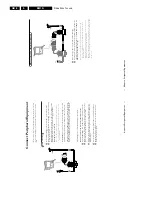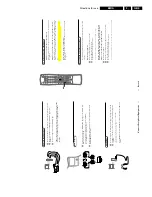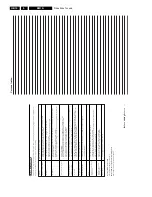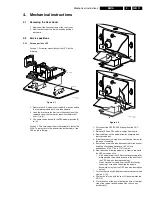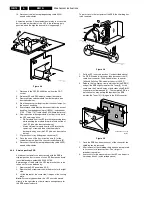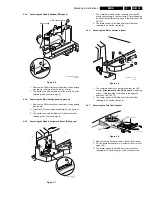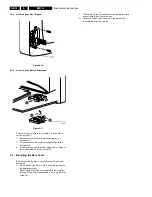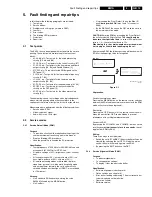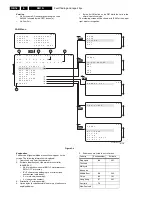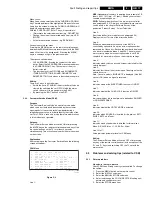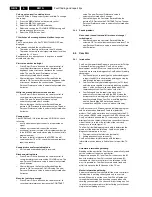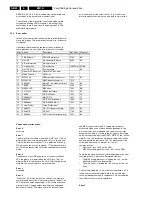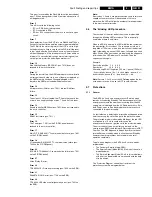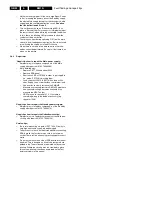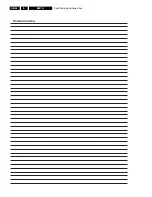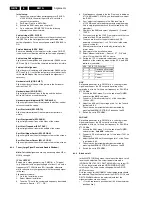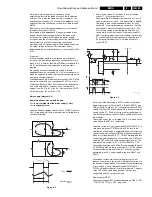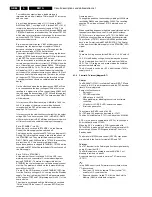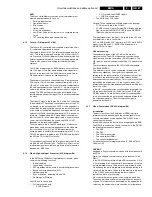
Fault finding and repair tips
GB 22
EM1A
5.
Figure 5-6
There are several types of protections:
•
I2C related protections (e.g. +5V supply check).
•
HOP related protections (mainly for deflection items).
•
Hardware errors which are not sensed by the Painter
(e.g. BRIDGE_PROT)
I2C related protections
In normal operation some registers of the I2C controlled IC's
will be refreshed every 200 msec. During this sequence the
I2C-busses and the I2C -IC's as well will be checked. The I2C
protection will take place if the SDA and SCL are whether
short-circuited to ground or to each other. An I2C error can
also occur, if the power supply of the IC is missing (e.g.
FBX_PROT; error 1).
HOP related protections
Every 200 msec. the status register of the HOP is read by the
Painter via I2C. If a protection signal is detected on one of the
inputs of the HOP, then the relevant error bit in the HOP
register is set to ‘high’. If the error bit is still ‘high’ after 1 sec.,
the Painter will store the error code in the error buffer (NVM)
and depending on the relevancy of the error bit the set will
either go into the protection-mode or not.
•
HFB: Horizontal Flyback. If the horizontal flyback is not
present, then this is detected via the HOP (HFB_X-
RAY_PROT). One status bit is set to ‘high’. The error
code is stored in the error buffer and the set will go into
the protection mode
•
Flash detection. From the EHT-info, via D6303 and
T7303 a flash will stop the H-drive and line output stage
immediately. The FLS-bit in the status register of the
HOP is set to ‘high’. As the duration of a flash is very
short the FLS-bit will be reset to ‘low’ again after the flash
refresh, so via a slow start the set will be started again.
Hardware related protections
Due to the architecture (with 'hot' deflection) there are two
protections that are 'unknown' to the microprocessor, namely
the 'BRIDGE_PROT' (coming from the line stage) and the
'DEFL_PROT' protection (coming from the frame deflection
stage). If one of these protections is triggered, the set is
positioned in ‘Standby’-mode. The Painter will now try to re-
start the set. If this will not succeed after 5 times (after
≈
30 -
60 s.), the Painter will generate error 7 (this error can have
several causes, such as a Flash, BRIDGE_PROT,
DEFL_PROT or a serious mains dip). A blinking red LED will
be started.
5.8
Repair tips
5.8.1
General
Figure 5-7
The start-up of the set is very different as of other sets (see
fig. 5-7 & 5-8):
1.
When the set is switched ‘ON’, first the HOP is placed in
'low power start-up' mode (HOP-standby-mode). This
means that 5 V (derived from available Standby-supply)
is connected to pin 22 of the HOP-IC.
2.
Now the HOP is driving the line-circuitry with 50 kHz
pulses. At the base of the line-transistor this is sensed via
the 'STANDBY’-line.
3.
This signal triggers the Main supply to operate. Now the
line-stage has 'BAT'-voltage (141 V), it will also start.
4.
After the 5 and 8 V-supply lines are sensed by the Painter
(via I
2
C), it will read the POR-bit from the HOP via the
I2C-bus.
5.
Now the HOP is switched in ‘ON’-mode and the set will
start-up further with normal drive (31.25 kHz for PAL).
6.
The last step will be the unblanking of the picture.
So standby is not controlled via a standby-line from
microprocessor, but is achieved indirectly via the HOP-
circuitry.
XPR (43)
FLS (5)
NHF (13)
HOP
PAINTER
EHT-INFO
BCL
HFB
+5V2
FLASH DETECT
I2C
I2C SLOW BUS
HIP
HOP
PICNIC
TUNER
NVM
MSP
I2C
I2C
PICNIC 3V3
FBX
PROTECTION
TUNER 8V
TUNER
PROTECTION
CL 06532111_055.eps
121000
X-RAY PROTECT
HFB X-RAY PROTECT
HOT
COLD
CL 06532111_056.eps
121000
HOP
DEFL.
PAINTER
MAIN SUPPLY
OUT
44
29
22
13
79
73
START/
STOP
START/
STOP
CUT OFF
STANDBY
STANDBY-POR
5V STANDBY
STANDBY-POR
STANDBY INFO
I
2
C-bus
POR-bit
IF NOT POR: ERROR 5 IS
GENERATED
(TEMPORARELY LOW THEN HIGH
LIKE STARTING A CAR)
(OUT)
RESET
7306
7324
7013
7308
NON-VFB
BRIDGE-PROT

